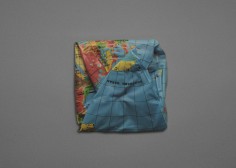MICHEL LE BELHOMME

source: loeildelaphotographie
Né en 1973, Michel Le Belhomme a étudié à l’école des Beaux-arts de Rennes, où il a notamment suivi l’enseignement de Tom Drahos (1999). En 2010, il a été lauréat du concours SFR Jeunes Talents, de la Mission Jeunes Artistes (Toulouse) et du premier « Prix lacritique.org – Voie Off » en Arles.
Michel Le Belhomme pratique le « lent protocole sculptural qui fait tableau » (Christian Gattinoni), dans le sillage des sculptures involontaires de Brassaï et des ready made à l’échelle et au point de vue rectifiés par Patrick Tosani. Du premier il a retenu l’utilisation des matériaux sans qualité, leur pouvoir de transformation. Du second il travaille la singularité des objets et leur métamorphose dans un jeu de proximité, perturbé par la distance et la variation d’échelle.
.
.
.
.
.
.
.
source: artsper
Né en 1973, Michel Le Belhomme a étudié à l’école des Beaux-arts de Rennes, où il a notamment suivi l’enseignement de Tom Drahos (1999).
Michel Le Belhomme pratique “le lent protocole sculptural qui fait tableau” (Christian Gattinoni), dans le sillage des sculptures involontaires de Brassaï et des ready made à l’échelle et au point de vue rectifié par Patrick Tosani. Du premier, il a retenu l’utilisation des matériaux sans qualité, leur pouvoir de transformation. Du second, il travaille la singularité des objets et de leur métamorphose dans un jeu de proximité, perturbé par la distance et la variation d’échelle.
Détachées d’une vision romantique et touristique du paysage, les recherches photographiques de Michel Le Belhomme développent un rapport ambigu à la représentation, entre document et fiction : en ce début du 21ème siècle postmoderniste et tranversal, la question de l’altérité nous obsède moins. Soit, il y a de l’incompréhensible, du dehors, de l’ailleurs, de l’hétérogène, de l’altération, etc. Il y a toutes sortes d’altérités, mais il est nécessaire d’opérer une mise en perspective critique, l’image est toujours le reflet d’une déchirure. Elle ne se forme que dans la déformation et la déconstruction et donc en résistance face à sa ‘‘légende’’. Prônant ainsi une photographie analytique, ses images placent le spectateur en situation de précarité visuelle, en quête de sens pour démêler le vrai du faux.
.
.
.
.
.
.
.
source: aintbadmagazine
Michel Le Belhomme was born in 1973 in France. He studied at Rennes Art School under Tom Drahos (1999). He then went on to study at the University Rennes 2 earning a Diploma supérior of Arts Education. In 2010 he one of the winners in the Mission Jeunes Artistes (Toulouse) and the first Prix lacrtique.org– Voies Off, in Arles. Today we share his series titled, The Blind Beast.
Photography is a paradoxical means of expression. On the one hand, it is accessible to all and on the other it is an artistic practice. Indeed, the world is full of photographic images: from the simple family album to the world of advertising, including the press; our force-fed eye knows no respite, our sight is constantly carried away by the swell of images, our point of view drowns – it becomes tragically diluted in the visual whirlpools around us. And despite it all, there are still artists whose boldness adds to this magma by introducing new subjects, ideas and ways of seeing and representing. And suddenly, something happens: a photograph emerges from chaos, takes on a shape, swells with singular might – and embeds itself long-lastingly in the visual realm.
First, we shall slide easily from a place represented to an imaginary place – I mean that these spaces that can, in theory, contain us, become spaces we contain. Those seemingly protective refuges, those precarious shelters, those homes diverted from their role of safety, are nothing more than rickety boxes in our troubled mind – they are mental boxes. Mental worries of the individual constantly torn between the desire to open himself to the world and explore it and the fear of being hurt or destroyed by its contact. Then, we notice great distress in the images of Michel Le Belhomme. We arrive on the scene after a catastrophe has taken place creating a certain traumatism. Everyday spaces have been vandalized by natural) or artificial forces, or both. Where thus is one to find hope in this desolate universe? Fascination for these photographs is therefore a result of their strange form as well as their ambiguous discourse. Opposing forces create a dynamic tension that crosses these falsely static places: emptiness and fullness, loss and profusion, outer and private, dream and nightmare, order and chaos, freedom and confinement, etc. This work is indeed pertinent because of its power of suggestion – for nothing is said directly – which takes us from the personal anecdote to the existential anguish that is more universal: no one is safe from the swell that can carry us both towards reason and towards delirium. Beware of the inner storm!

